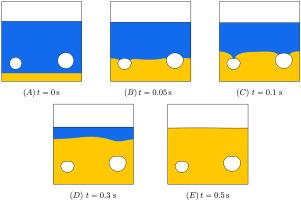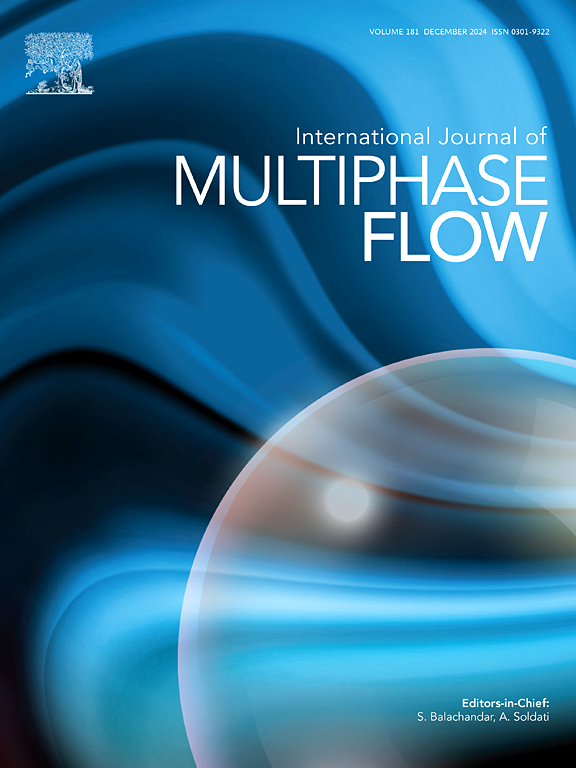A consistent, volume preserving, and adaptive mesh refinement-based framework for modeling non-isothermal gas–liquid–solid flows with phase change
IF 3.6
2区 工程技术
Q1 MECHANICS
International Journal of Multiphase Flow
Pub Date : 2024-11-19
DOI:10.1016/j.ijmultiphaseflow.2024.105060
引用次数: 0
Abstract
This work expands on our recently introduced low Mach enthalpy method (Thirumalaisamy and Bhalla 2023) for simulating the melting and solidification of a phase change material (PCM) alongside (or without) an ambient gas phase. The method captures PCM’s volume change (shrinkage or expansion) by accounting for density change-induced flows. We present several improvements to the original work. First, we introduce consistent time integration schemes for the mass, momentum, and enthalpy equations, which enhance the method stability. Demonstrating the effectiveness of this scheme, we show that a system free of external forces and heat sources can conserve its initial mass, momentum, enthalpy, and phase composition. This allows the system to transition from a non-isothermal, non-equilibrium, phase-changing state to an isothermal, equilibrium state without exhibiting unrealistic behavior. Furthermore, we show that the low Mach enthalpy method accurately simulates thermocapillary flows without introducing spurious phase changes. To reduce computational costs, we solve the governing equations on adaptively refined grids. We investigate two cell tagging/untagging criteria and find that a gradient-based approach is more effective. This approach ensures that the moving thin mushy region is always captured at fine grid levels, even when it temporarily falls within a subgrid level. We propose an analytical model to validate advanced computational fluid dynamics (CFD) codes used to simulate metal manufacturing processes (welding, 3D printing). These processes involve a heat source (like a laser) melting metal or its alloy in the presence of an ambient (inert) gas. Traditionally, studies relied on artificially manipulating material properties to match complex experiments for validation purposes. Leveraging the analytical solution to the Stefan problem with a density jump, this model offers a straightforward approach to validating multiphysics simulations involving heat sources and phase change phenomena in three-phase flows. Lastly, we demonstrate the practical utility of the method in modeling porosity defects (gas bubble trapping) during metal solidification. A field extension technique is used to accurately apply surface tension forces in a three-phase flow situation. This is where part of the bubble surface is trapped within the (moving) solidification front.

基于一致、体积保持和自适应网格细化的非等温气液固相变流动建模框架
这项工作扩展了我们最近推出的低马赫焓法(Thirumalaisamy 和 Bhalla,2023 年),用于模拟相变材料(PCM)与环境气相(或不与环境气相)一起熔化和凝固的过程。该方法通过考虑密度变化引起的流动来捕捉 PCM 的体积变化(收缩或膨胀)。我们提出了几项对原始工作的改进。首先,我们为质量、动量和焓等式引入了一致的时间积分方案,从而提高了方法的稳定性。为了证明这一方案的有效性,我们展示了一个没有外力和热源的系统可以保持其初始质量、动量、焓和相组成。这使得系统可以从非等温、非平衡、相变状态过渡到等温、平衡状态,而不会表现出不切实际的行为。此外,我们还证明了低马赫焓法可精确模拟热毛细管流,而不会引入虚假相变。为了降低计算成本,我们在自适应细化网格上求解了控制方程。我们研究了两种单元标记/不标记标准,发现基于梯度的方法更为有效。这种方法能确保移动的稀薄粘稠区域始终被精细网格捕获,即使它暂时位于子网格内。我们提出了一个分析模型来验证用于模拟金属制造过程(焊接、3D 打印)的先进计算流体动力学 (CFD) 代码。这些过程涉及热源(如激光)在环境(惰性)气体中熔化金属或其合金。传统的研究依赖于人为操纵材料特性,以匹配复杂的实验,从而达到验证目的。利用密度跃迁的斯特凡问题分析解决方案,该模型为验证三相流中涉及热源和相变现象的多物理场模拟提供了一种直接的方法。最后,我们展示了该方法在模拟金属凝固过程中孔隙缺陷(气泡捕获)方面的实用性。场扩展技术用于在三相流情况下精确应用表面张力。在这种情况下,部分气泡表面被困在(移动的)凝固前沿内。
本文章由计算机程序翻译,如有差异,请以英文原文为准。
求助全文
约1分钟内获得全文
求助全文
来源期刊
CiteScore
7.30
自引率
10.50%
发文量
244
审稿时长
4 months
期刊介绍:
The International Journal of Multiphase Flow publishes analytical, numerical and experimental articles of lasting interest. The scope of the journal includes all aspects of mass, momentum and energy exchange phenomena among different phases such as occur in disperse flows, gas–liquid and liquid–liquid flows, flows in porous media, boiling, granular flows and others.
The journal publishes full papers, brief communications and conference announcements.

 求助内容:
求助内容: 应助结果提醒方式:
应助结果提醒方式:


